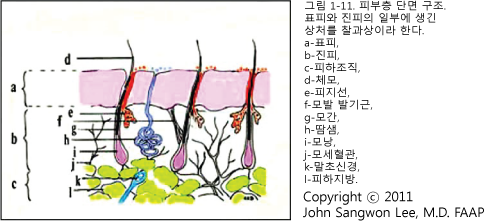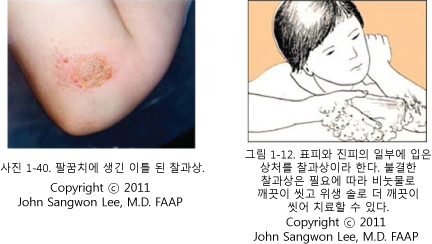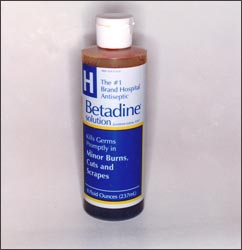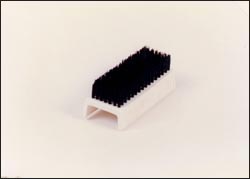Contusions, Abrasions(Scrapes) 좌상, 찰과상
- In the United States, in 2005, 11.8 million people received emergency treatment at emergency medical centers for acute skin injuries.
- More than 500,000 of them are burned,
- 7,300 thousand people were reincarnated,
- 2 million people have been treated for cuts and punctures,
- It is said that 4,700,000 people are bitten by animals every year (Source: NEJM September 2008 p.1037).
- If minor trauma such as burns, cuts, lacerations, cuts, and abrasions occurs on children and adolescents (0-18 years old),
- in most cases, parents themselves are the first step at the site of the trauma accident before receiving the first initial treatment from a doctor.
- It is common to give priority to first aid.
- Sometimes parents themselves continue to perform catch-up treatment as needed. Or,
- it is common for the parents themselves to give priority to first aid at the accident site, and then receive catch-up emergency treatment at the pediatrics department or at the hospital emergency room.
- Parents must be at least the half -doctors in order to appropriately take the first aid at the accident site for burns, cuts, lacerations, cuts and abrasions that occurred to children and young children.
- When minor traumas such as burns, cuts, lacerations, cuts and abrasions occur to children and adolescents, the first step that parents can do at the site of the accident, first-aid measures for acute skin damage (acute cutaneous wounds management)
- The following will be explained. In most cases, parents often have to do the first treatment at the accident site.

Causes of contusions and abrasions
- Skin injuries without skin breakage are called contusion or bruises.
- Damage to the brain parenchyma without breakage is called brain contusion.
- Here, we mainly describe the contusion on the skin.
- Children and adolescents have strong physical activity, play badly, and do a lot of physical exercises, so various traumas such as contusions, abrasions, and lacerations occur almost every day.
- Sometimes, the skin may suffer severe contusions, and both strains and abrasions can occur at the same time.
- When a part of the skin is severely contusions or rubbed, the epidermal layer of the skin is thinly peeled off and a small amount of blood is formed on the skin is called abrasion.
- Abrasions are more common on the face, knees, limbs, and torso due to a fall or a traffic accident.

Symptoms of contusions and abrasion
- The upper wound is swollen and painful.
- The function of the wound area where the abrasion has occurred may be limited.
- After a day or two, it turns red and bruises.
- Symptoms vary slightly depending on the severity of the abrasion.
- In general, skin wounds caused by abrasions are sore and painful, and a little swelling and a little swelling and blood formation are common.
- ‘After 2-3 days of abrasion, the abrasion wound is bruised black or red. If not treated properly, the contusion and abrasion wound can become infected with bacteria and fester the wound.
- In the event of abrasion, dirt can enter the skin layer or subcutaneous tissue where the abrasion wound is located.
Treatment of the contusion and abrasion
- If the affected part of the body hurts or swollen, applying cold water or ice to the left wound right away can make it less painful and less swollen.
- If the compression wound or left-wound caused by pressure is large or continues to be painful and swollen, treat it according to the doctor’s instructions.
- Emergency treatment is given a little differently depending on the size and extent of the abrasion and where the abrasion is located on the body.
- When the abrasion is small and relatively clean, it can be left as it is for observational treatment, or after washing with soapy water or a disinfectant soapy water, sterilization treatment can be performed with such as betadine solution disinfectant.
- It can be treated by applying a topical antibiotic ointment such as Neosporin.
- If the abrasion wound is dirty and infected with bacteria, wash the dirt thoroughly with soap and water with a disinfectant.
- Antibiotics for application to wounds can be used to treat infections.
- You may be allergic to betadine solution disinfectants.
- Before treating with betadine solution disinfectant, you should find out if your child is allergic to betadine solution disinfectant.
- If your child is not allergic to betadine liquid disinfectant, the abrasion wound should not be washed with soapy water but washed with betadine liquid disinfectant, and the wound covered with a disposable band-aid should be treated.

▴ Photo 1-41. Betadine solution disinfectant is used in the United States without a doctor’s prescription. It can be stored and used as a household medicine at a pharmacy. Copyright ⓒ 2011 John Sangwon Lee, MD., FAAP
- Depending on the size and extent of the abrasion wound, sterilization treatment is performed to treat the abrasion, and an antibiotic ointment for application such as Neosporin ointment is applied to the wound, and the abrasion can be treated by covering the abrasion with a disposable band-aid or sterile gauze.
- We do not recommend emergency treatment of abrasion wounds with alcohol sterilization.
- Small and minor abrasions can be healed by sterilization treatment with a betadine solution disinfectant
- ([Parents must also be at least the half–doctors-Encyclopedia of Pediatrics and Family Nursing)-Volume 21 Children and Adolescents Home School Nursing-Disinfectants.)
- If dust, dirt, sand, etc. is buried on the surface of the abrasion wound, or if it is deeply embedded in the abrasion wound, or is dirty due to dirt on the abrasion, wash it thoroughly with soapy water or dust on the abrasion wound with clean gauze or medical brush (refer to Photo 49) B.
- Wash and treat dirt, sand, and other dirt carefully.
- When treated like this, it hurts a little and the wound may bleed a little.
- Sometimes, local anesthesia for the abrasion is performed and the dirt is washed away.
- Unclean abrasions are washed with soapy water, and then washed further with betadine disinfectant and sterilized.
- Then, the abrasion can be covered with sterile gauze and fixed with a bandage or band-aid.
- When the skin from the abrasion wound is dry and not festered, remove the covered gauze.
- Change with new gauze as needed.
- Get the tetanus vaccine as directed by your doctor.

▴ Photo 1-41. If necessary, wash the dirt off the abrasion wound with clean water. Sometimes you can wash it more thoroughly with a hygiene brush.
Copyright ⓒ 2011 John Sangwon Lee, MD., FAAP
- When the upper wound is hot and painful, pain relievers such as Tylenol are used. If the abrasion wound is festered or a foreign object such as sand or wood is deep inside the abrasion wound, the foreign body should be properly removed at the hospital.
- Replace the wound covered with gauze or disposable band-aids with new ones every 1-2 days.
- Whenever changing gauze, etc., either Neosporin antibiotic ointment for skin application, bacitracin antibiotic ointment, or Bactroban antibiotic ointment is applied to prevent festering, or re-sterilization treatment with betadine solution disinfectant.
- If the abrasion wound is large or dirty, or if you are unsure of what to do at home, you should consult your doctor for appropriate treatment.
- When the abrasion wound is festered, it is appropriately treated with oral antibiotics or intravenous antibiotics.
- If the abrasion wound occurs on the entire skin layer and the width is greater than 1㎠ or does not heal within 2 weeks after the abrasion, it is recommended to seek treatment by a plastic surgeon (source; NEJM September 2008 p.1037).
- The following is an example of the Internet pediatric and adolescent health counseling question and answer about “wounds near the eyes, abrasions,”
. Q&A.
- Wounds near the eyes, abrasions,
- Thank you for the last reply.
- I have a 9-month girl.
- A scratch has occurred near the eyes and just under the lower eyelid.
- It looks like that when she rubs your eyes.
- I always cut my nails short..
- What kind of medicine should I use?
- Whenever I get sleepy, I rub it and it’s often wet due to tears, so it doesn’t heal well, and I’m afraid it might get infected.
- There are betadine liquid disinfectants or Neosporin, but I don’t apply them because they seem to get into my eyes.
- Please let me know if there are any medicines that can be applied around the eyes.
- Dear mother Hello. Thanks for asking. That’s a good question. The more information you know about your child’s age, gender, past medical history, family medical history, medical examination findings, and clinical examination, the more helpful it is to give you an answer.
- We will respond based on the information you provided.
- Apply a little bit of skin disinfectant such as betadine solution disinfectant to the Q tip and apply it lightly to the affected area, and wait for 1 to 2 minutes so that some of the applied disinfectants may be absorbed into the blood through the skin.
- When a very small amount of betadine disinfectant enters the eyes of a girl’s child, tears come out of the eyes, and the betadine disinfectant is diluted and washed away with tears.
- Even if you perform sterilization treatment with betadine solution disinfectant, there is no need to worry too much.
- Betadine solution disinfectant may cause allergies, so it should be used with care. It can be treated with Neosporin antibiotic ointment.
- Please read the instructions carefully before starting treatment.
- Refer to [Parents should also be at least the half-doctors-Child and Family Nursing]-Volume 21 Children and Adolescents, Home School Nursing, and Disinfectants for Home Nursing.
- If you have more questions, please contact us again.
- Thank you.
- May you be healthy and blessed in the new year, and all things prosper.
- Lee Sang-won ., MD